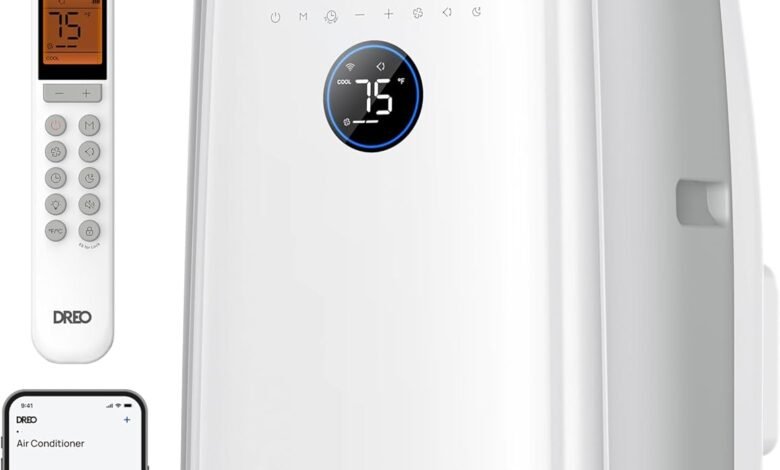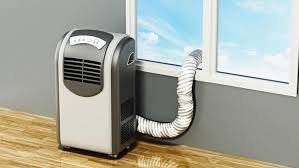Title: The Ultimate Guide to Portable AC Units: Stay Cool Anywhere, Anytime

Introduction: What Is a Portable AC Unit and Why You Might Need One
Portable AC units are a lifesaver during hot summer months, especially when traditional air conditioning systems just won’t cut it—or aren’t available at all. These compact, mobile cooling devices can be wheeled into any room and plugged into a standard outlet, giving you instant relief from heat. Whether you’re living in a small apartment, renting, or just need to cool a specific space like your home office or bedroom, a portable AC unit can be your best friend.
The real beauty of a portable air conditioner lies in its flexibility. You’re not tied to one room, and there’s no complicated installation process involving multiple contractors. All you need is a window or a vent to expel the warm air and you’re good to go. Plus, modern portable units come with added perks like built-in dehumidifiers, air purifiers, and smart home compatibility.
Many people make the mistake of thinking portable ACs are weak or inefficient, but technology has come a long way. Today’s models can cool large spaces, maintain energy efficiency, and even work quietly—making them a solid investment if used right.
How Do Portable AC Units Work?

Understanding how these devices operate will help you choose the right one and maintain it properly. In simple terms, a portable AC unit works just like any other air conditioning system: it pulls in warm air from your room, cools it down using refrigerant, and then releases the cooler air back into your space. Meanwhile, the hot air is vented out through a window or sliding door using an exhaust hose.
Most portable ACs are single-hose units, meaning they use one hose to pull in and expel air. There are also dual-hose units, which tend to be more efficient. One hose pulls air from the outside to cool the compressor, and the second expels the warm air from the room. Dual-hose systems cool faster and use less energy, but they’re typically more expensive.
Portable units usually have a water reservoir to collect humidity as they dehumidify the room. Some models require you to manually empty the water, while others come with auto-evaporation features that take care of it for you. Some also have a continuous drain option, which is handy if you live in a particularly humid area.
Knowing the technical side of things might seem intimidating, but trust me—it’s worth it. A little understanding goes a long way in making your purchase more informed and your cooling experience more efficient.
Choosing the Right Portable AC for Your Space
Not all portable air conditioners are created equal. Choosing the right one depends on a few key factors: the size of the space you need to cool, the climate you live in, and the features you want.
The most important number to look for is the BTU rating (British Thermal Units). A unit with a higher BTU can cool a larger area. For example, a 10,000 BTU unit is typically good for rooms up to 300 square feet, while a 14,000 BTU unit can handle rooms as big as 500 square feet or more. If you pick a unit that’s too weak for your room size, it will struggle to cool efficiently and rack up your energy bill.
Also, think about where you’re placing it. Is there enough space for ventilation? Will the hose reach the window? How noisy is it? Some units can be surprisingly loud—something you definitely want to avoid in a bedroom or workspace.
You should also consider energy efficiency. Look for models with an Energy Efficiency Ratio (EER) rating or Energy Star certification. It’s better for your wallet and the planet. Smart features like remote control, Wi-Fi connectivity, programmable timers, and sleep modes can also make a big difference in how convenient your unit is to use daily.
Pros and Cons of Portable AC Units
Like anything else, portable air conditioners have their pros and cons. Being aware of them can help set realistic expectations and avoid disappointment.
Pros:
One of the biggest advantages is portability. Unlike window units or split AC systems, you can easily move a portable AC around to wherever you need it. That makes them ideal for renters or people living in older homes where installing a permanent system isn’t an option.
Another plus is ease of setup. You don’t need to be an HVAC expert to get one running. Just plug it in, attach the hose to a window kit, and you’re good to go. Many people also love the extra features, like air purifiers or dehumidifiers, which help improve indoor air quality.
Cons:
Now, the flip side. Portable AC units can be noisy, especially cheaper models. They’re also less efficient than traditional systems, and if you’re cooling a large space, the electricity cost can add up quickly. Additionally, they take up floor space, which might be a problem in smaller rooms.
Another thing people often overlook is the need to vent the unit. If you can’t connect it to a window or sliding door, it simply won’t work properly. And don’t forget about maintenance—if your unit doesn’t have auto-evaporation, you’ll need to remember to empty the water tank regularly.
Tips for Getting the Most Out of Your Portable AC
Getting the best performance from your portable AC isn’t just about buying the most expensive model—it’s about using it wisely. First, make sure the exhaust hose is straight and not kinked. A blocked hose restricts airflow and forces the unit to work harder, which isn’t good for efficiency or longevity.
You should also insulate your room as much as possible. Close the blinds during the day, seal any air leaks around windows, and try to limit heat-generating activities like cooking. The cooler your room is to start with, the less your AC has to do.
Clean or replace the air filters regularly. Dirty filters restrict airflow and reduce cooling performance. Most manufacturers recommend cleaning them every two weeks during heavy use. Also, check the water tank if your unit has one—don’t wait for it to overflow!
Last but not least, don’t forget to store your AC properly during off-seasons. Drain all water, clean the unit thoroughly, and cover it to protect it from dust. Taking good care of your portable AC ensures it’s ready to go whenever summer returns.
Best Brands and Models to Consider
There are dozens of portable AC brands out there, but a few stand out for their quality, reliability, and customer satisfaction. Some of the top-rated brands include Whynter, Honeywell, LG, Frigidaire, and Black+Decker.
- Whynter ARC-14S is known for its powerful dual-hose system and high cooling efficiency. It’s a favorite among tech-savvy users and those who want quick results.
- Honeywell HL series models are reliable and feature-rich, often including dehumidifiers and remote controls. They also run a bit quieter than many competitors.
- LG portable units tend to be stylish and packed with smart features like app control and energy-saving modes. Perfect for modern homes.
- Black+Decker BPACT14WT is a great budget-friendly option that performs well for smaller spaces. It’s compact, easy to set up, and doesn’t skimp on power.
Make sure to check reviews and compare features before buying. What works great for one household might be a poor fit for another.
Conclusion: Is a Portable AC Unit Right for You?
In the end, a portable AC unit can be a fantastic solution if you’re looking for flexibility, ease of use, and an effective way to stay cool without breaking the bank. Whether you’re a renter, a student in a dorm, or just need to supplement your current cooling system, there’s likely a portable AC that fits your needs perfectly.
Yes, they have their limitations. But with the right choice and a few smart usage tips, you can enjoy a comfortable indoor climate no matter how high the temperature climbs outside. Think of it as an investment in comfort—one that you can take with you wherever you go.
If you’re sweating over your options, don’t worry—you’re not alone. But with this guide in hand, you’re already a few steps closer to staying cool all summer long.



